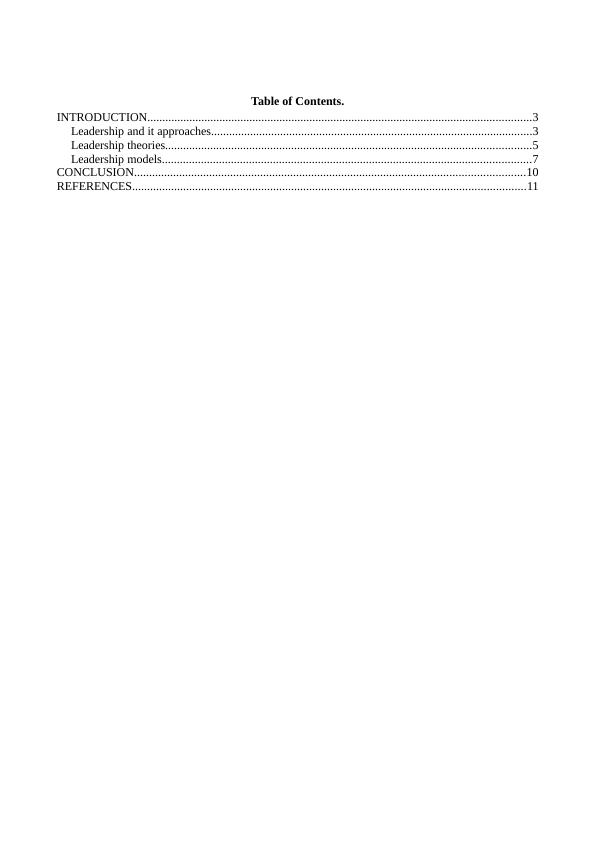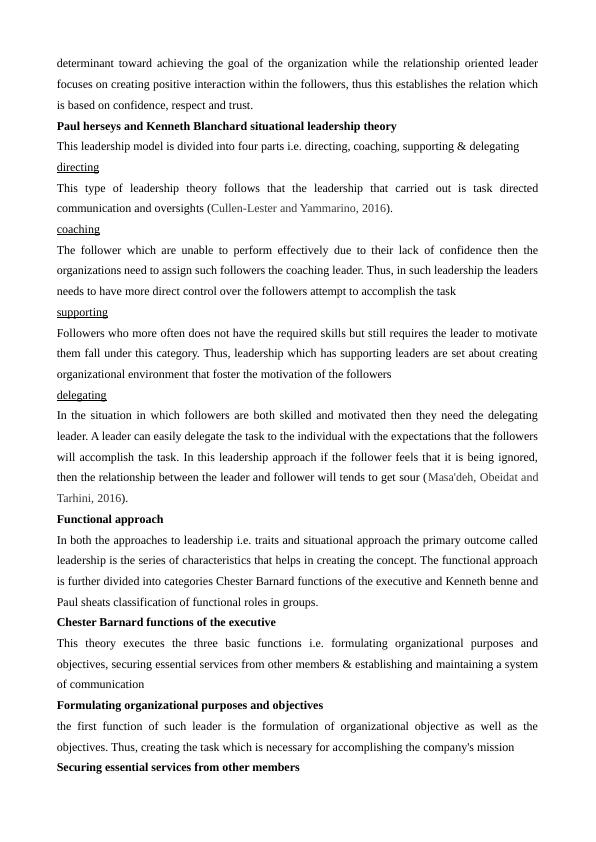Introduction to Managing and Leading People
Added on 2023-01-19
11 Pages3501 Words32 Views
UGB164
the Introduction to Managing
and Leading People
Assessment 2019
the Introduction to Managing
and Leading People
Assessment 2019

Table of Contents.
INTRODUCTION................................................................................................................................3
Leadership and it approaches...........................................................................................................3
Leadership theories..........................................................................................................................5
Leadership models...........................................................................................................................7
CONCLUSION..................................................................................................................................10
REFERENCES...................................................................................................................................11
INTRODUCTION................................................................................................................................3
Leadership and it approaches...........................................................................................................3
Leadership theories..........................................................................................................................5
Leadership models...........................................................................................................................7
CONCLUSION..................................................................................................................................10
REFERENCES...................................................................................................................................11

INTRODUCTION
Leadership is the process by which an executive can direct, guide as well as influence the behaviour
as well as the work of the others. Leadership is the ability of the manager to introduce subordinates
to the work with appropriate zeal and confidence. The organizational leader has the potential to
influence behaviours of the others. It is also defined as the capacity to influence a group towards
accomplishment of specific goals. Thus, leaders are required to develop future visions and to
motivate the organizational members to want to achieve the visions in an effective manner. In this
report it has been discussed the various approaches to leadership, followed by the various leadership
theories, moreover in this report we have also discussed the various leadership models (Anderson
and et.al, 2017).
Leadership and its approaches, theories & models are been discussed below
Leadership and it approaches
Trait approach
The most basic qualities possessed by the effective leader is the traits of personality, mental &
physical, these traits are only possessed by the effective leader and these are absent in ineffective
leaders. This leadership approach is one of the oldest approach of leadership which is still in
practice. According to some authors it is suggested that the personality trait of leader can be
determined by way the leader treats its team members. Thus, there are various leadership situations
in which the trait of personality is seen absent all within the leadership of the organization. Even the
communication researcher has examined the possible relationships between leaders & varying
communicative traits.
Situational approach
This approach of leadership is mainly dependent various factors other than the traits such as
follower motivation and commitments, leader follower relationships and interactions and task to be
completed. Thus, these new theories of leadership are commonly known as the situational
leadership approaches (Zhang, Huai and Xie, 2015). The situational leadership approach is further
divided into various categories Fred fielder's contingency theory & Paul herseys and Kenneth
Blanchard situational leadership theory.
Fred fielder's contingency theory
This researcher suggested that the leader doesn't change it leadership style on its own but the
situation tends the leader to change its leadership style thus these leaders adopt the leadership
strategies. The researcher predicted that the leadership is typically the notion of either relationship
oriented or the task oriented. Therefore, task oriented leaders are the one which are more
Leadership is the process by which an executive can direct, guide as well as influence the behaviour
as well as the work of the others. Leadership is the ability of the manager to introduce subordinates
to the work with appropriate zeal and confidence. The organizational leader has the potential to
influence behaviours of the others. It is also defined as the capacity to influence a group towards
accomplishment of specific goals. Thus, leaders are required to develop future visions and to
motivate the organizational members to want to achieve the visions in an effective manner. In this
report it has been discussed the various approaches to leadership, followed by the various leadership
theories, moreover in this report we have also discussed the various leadership models (Anderson
and et.al, 2017).
Leadership and its approaches, theories & models are been discussed below
Leadership and it approaches
Trait approach
The most basic qualities possessed by the effective leader is the traits of personality, mental &
physical, these traits are only possessed by the effective leader and these are absent in ineffective
leaders. This leadership approach is one of the oldest approach of leadership which is still in
practice. According to some authors it is suggested that the personality trait of leader can be
determined by way the leader treats its team members. Thus, there are various leadership situations
in which the trait of personality is seen absent all within the leadership of the organization. Even the
communication researcher has examined the possible relationships between leaders & varying
communicative traits.
Situational approach
This approach of leadership is mainly dependent various factors other than the traits such as
follower motivation and commitments, leader follower relationships and interactions and task to be
completed. Thus, these new theories of leadership are commonly known as the situational
leadership approaches (Zhang, Huai and Xie, 2015). The situational leadership approach is further
divided into various categories Fred fielder's contingency theory & Paul herseys and Kenneth
Blanchard situational leadership theory.
Fred fielder's contingency theory
This researcher suggested that the leader doesn't change it leadership style on its own but the
situation tends the leader to change its leadership style thus these leaders adopt the leadership
strategies. The researcher predicted that the leadership is typically the notion of either relationship
oriented or the task oriented. Therefore, task oriented leaders are the one which are more

determinant toward achieving the goal of the organization while the relationship oriented leader
focuses on creating positive interaction within the followers, thus this establishes the relation which
is based on confidence, respect and trust.
Paul herseys and Kenneth Blanchard situational leadership theory
This leadership model is divided into four parts i.e. directing, coaching, supporting & delegating
directing
This type of leadership theory follows that the leadership that carried out is task directed
communication and oversights (Cullen-Lester and Yammarino, 2016).
coaching
The follower which are unable to perform effectively due to their lack of confidence then the
organizations need to assign such followers the coaching leader. Thus, in such leadership the leaders
needs to have more direct control over the followers attempt to accomplish the task
supporting
Followers who more often does not have the required skills but still requires the leader to motivate
them fall under this category. Thus, leadership which has supporting leaders are set about creating
organizational environment that foster the motivation of the followers
delegating
In the situation in which followers are both skilled and motivated then they need the delegating
leader. A leader can easily delegate the task to the individual with the expectations that the followers
will accomplish the task. In this leadership approach if the follower feels that it is being ignored,
then the relationship between the leader and follower will tends to get sour (Masa'deh, Obeidat and
Tarhini, 2016).
Functional approach
In both the approaches to leadership i.e. traits and situational approach the primary outcome called
leadership is the series of characteristics that helps in creating the concept. The functional approach
is further divided into categories Chester Barnard functions of the executive and Kenneth benne and
Paul sheats classification of functional roles in groups.
Chester Barnard functions of the executive
This theory executes the three basic functions i.e. formulating organizational purposes and
objectives, securing essential services from other members & establishing and maintaining a system
of communication
Formulating organizational purposes and objectives
the first function of such leader is the formulation of organizational objective as well as the
objectives. Thus, creating the task which is necessary for accomplishing the company's mission
Securing essential services from other members
focuses on creating positive interaction within the followers, thus this establishes the relation which
is based on confidence, respect and trust.
Paul herseys and Kenneth Blanchard situational leadership theory
This leadership model is divided into four parts i.e. directing, coaching, supporting & delegating
directing
This type of leadership theory follows that the leadership that carried out is task directed
communication and oversights (Cullen-Lester and Yammarino, 2016).
coaching
The follower which are unable to perform effectively due to their lack of confidence then the
organizations need to assign such followers the coaching leader. Thus, in such leadership the leaders
needs to have more direct control over the followers attempt to accomplish the task
supporting
Followers who more often does not have the required skills but still requires the leader to motivate
them fall under this category. Thus, leadership which has supporting leaders are set about creating
organizational environment that foster the motivation of the followers
delegating
In the situation in which followers are both skilled and motivated then they need the delegating
leader. A leader can easily delegate the task to the individual with the expectations that the followers
will accomplish the task. In this leadership approach if the follower feels that it is being ignored,
then the relationship between the leader and follower will tends to get sour (Masa'deh, Obeidat and
Tarhini, 2016).
Functional approach
In both the approaches to leadership i.e. traits and situational approach the primary outcome called
leadership is the series of characteristics that helps in creating the concept. The functional approach
is further divided into categories Chester Barnard functions of the executive and Kenneth benne and
Paul sheats classification of functional roles in groups.
Chester Barnard functions of the executive
This theory executes the three basic functions i.e. formulating organizational purposes and
objectives, securing essential services from other members & establishing and maintaining a system
of communication
Formulating organizational purposes and objectives
the first function of such leader is the formulation of organizational objective as well as the
objectives. Thus, creating the task which is necessary for accomplishing the company's mission
Securing essential services from other members

End of preview
Want to access all the pages? Upload your documents or become a member.
Related Documents
Leadership Approaches, Theories & Modelslg...
|2
|869
|47
Situational Leadership Theory and Kolb's Theory of Experiential Learninglg...
|8
|1414
|358
Managing Organizations and Leading People Assignment 2022lg...
|4
|760
|17
Leadership and Management Theories and Practices: A Case Study of Jeff Bezos and Amazonlg...
|20
|1060
|305
Leadership in Contemporary Organization Case Study 2022lg...
|16
|3268
|15
Types of Leadership Theories and Their Impacts on Businesslg...
|12
|2637
|85